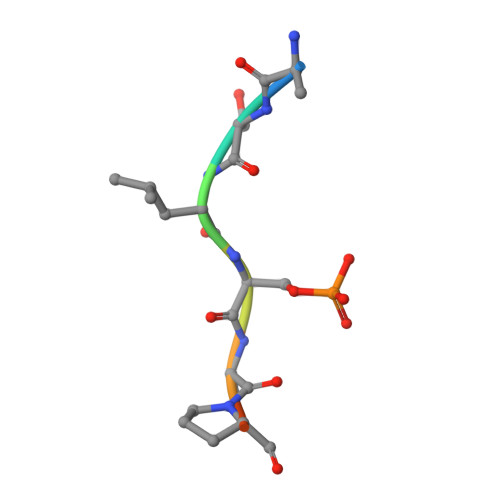14-3-3 protein directly interacts with the kinase domain of calcium/calmodulin-dependent protein kinase kinase (CaMKK2).
Psenakova, K., Petrvalska, O., Kylarova, S., Lentini Santo, D., Kalabova, D., Herman, P., Obsilova, V., Obsil, T.(2018) Biochim Biophys Acta 1862: 1612-1625
- PubMed: 29649512
- DOI: https://doi.org/10.1016/j.bbagen.2018.04.006
- Primary Citation of Related Structures:
6EWW, 6FEL - PubMed Abstract:
Calcium/calmodulin-dependent protein kinase kinase 2 (CaMKK2) is a member of the Ca 2+ /calmodulin-dependent kinase (CaMK) family involved in adiposity regulation, glucose homeostasis and cancer. This upstream activator of CaMKI, CaMKIV and AMP-activated protein kinase is inhibited by phosphorylation, which also triggers an association with the scaffolding protein 14-3-3. However, the role of 14-3-3 in the regulation of CaMKK2 remains unknown. The interaction between phosphorylated CaMKK2 and the 14-3-3γ protein, as well as the architecture of their complex, were studied using enzyme activity measurements, small-angle x-ray scattering (SAXS), time-resolved fluorescence spectroscopy and protein crystallography. Our data suggest that the 14-3-3 protein binding does not inhibit the catalytic activity of phosphorylated CaMKK2 but rather slows down its dephosphorylation. Structural analysis indicated that the complex is flexible and that CaMKK2 is located outside the phosphopeptide-binding central channel of the 14-3-3γ dimer. Furthermore, 14-3-3γ appears to interact with and affect the structure of several regions of CaMKK2 outside the 14-3-3 binding motifs. In addition, the structural basis of interactions between 14-3-3 and the 14-3-3 binding motifs of CaMKK2 were elucidated by determining the crystal structures of phosphopeptides containing these motifs bound to 14-3-3. 14-3-3γ protein directly interacts with the kinase domain of CaMKK2 and the region containing the inhibitory phosphorylation site Thr 145 within the N-terminal extension. Our results suggested that CaMKK isoforms differ in their 14-3-3-mediated regulations and that the interaction between 14-3-3 protein and the N-terminal 14-3-3-binding motif of CaMKK2 might be stabilized by small-molecule compounds.
Organizational Affiliation:
Department of Physical and Macromolecular Chemistry, Faculty of Science, Charles University, Prague, Czech Republic; BioCeV - Institute of Physiology, The Czech Academy of Sciences, Vestec, Czech Republic.
















